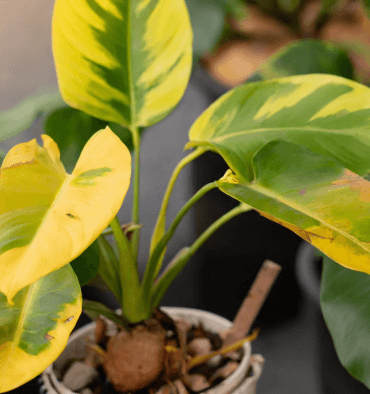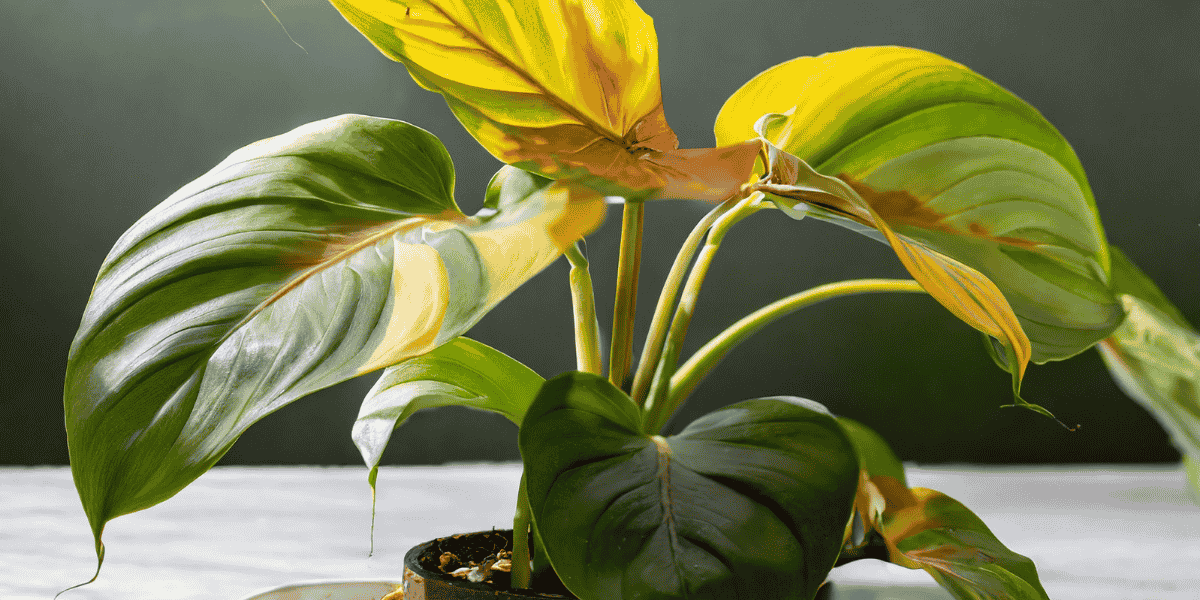Introduction:
Yellowing and rotting smell from your Philodendron are common issues that arise from overwatering or unsuitable lighting. Popular houseplants, philodendrons are known for their colorful leaves and low maintenance requirements. They might still face several problems, especially those related to water and their surroundings. Yellowing leaves are a frequent issue that often comes on by overwatering or unsuitable lighting. Overwatering philodendron plants can cause their roots to become soft, which can result in root rot and eventually the plant’s leaves turning yellow. These problems can be avoided by using appropriate watering techniques and positioning them in an area with indirect sunlight. Water collection is also less likely if you use a pot that drains well and ensures the soil is not packed.
Yellowing and Rotting Smell in Philodendrons

A rotting smell coming from a philodendron is typically an indication of unhealthy roots, especially when it is matched by yellowing. Root rot, which is brought on by standing water in the soil, is usually the source of the unpleasant smell. To fix this, carefully take the plant out of its pot and look for burned or mushy roots. After trimming them off, the plant needs to be repotted in new soil that drains properly. Additionally, moisture affects the plant’s general health; excessive humidity in the air may cause the leaves to turn yellow and give off a smelly or rotten smell. The plant’s recovery can also be helped by regularly cleaning the leaves to improve photosynthesis and avoid collecting dirt. The plant will flourish if you keep the temperature temperate and don’t overwater it.
Common Causes of Yellowing and Rotting smell in your Philodendron Leaves
The lush and green tropical leaves of philodendron plants may turn yellow as a sign of sorrow. Overwatering is a common cause of this. Standing water in the pot from too much water damages the plant’s roots and causes root rot. The roots begin dying and release an unpleasant rotting smell if they are left in water for a long period of time. Making sure that the soil for your philodendron stays moist but not soggy is necessary. Also, any extra water should always be able to exit through the drainage hole at the bottom of the pot.
Nutrient Deficiencies and Their Impact on the Yellowing and Rotting Smell from Your Philodendron
Another reason for yellowing leaves can be a nutritional deficiency. A lack of essential nutrients like iron, magnesium, and calcium leads to chlorosis, where the plant’s leaves turn pale and yellow. This can happen when the soil doesn’t provide enough nutritional value or when the plant hasn’t been fertilized for a while. Additionally, extreme temperature shifts and overexposure to sunlight can stress your plant, causing yellowish spots to appear.
Environmental Stress and the Yellowing and Rotting Smell from Your Philodendron
Because it prefers medium sunlight, make sure your philodendron is in bright indirect sunlight. The leaves may become damaged by direct sunlight, which can result in marks and burning. To prevent more stress, keep the plant in a regularly moist atmosphere. The edges of the leaves may start to droop and become brown and then yellow if the humidity level is too low.
Understanding the Rotting Smell
The Cause of the Yellowing and Rotting Smell from Your Philodendron
A rotting smell coming from a philodendron plant can be a warning sign that something is wrong. Excess moisture in the soil, which provides an ideal environment for harmful fungi, is frequently the source of the bad smell. As a result, there is root rot and an unpleasant smell. Regularly wet or moist soil removes the roots of plants of oxygen, which leads to their decay. The leaves are going to turn yellow as a result, and the roots will get wet, brown, or reddish. This problem gets worse by improper drainage or overwatering; thus, it’s important to regularly inspect the state of the soil.
How to Address the Problem
In my experience, the best way to address this problem is to improve the plant’s drainage and avoid overwatering. If your plant’s soil feels soaked to the touch, it’s time to take action. Over time, without proper care, fungal diseases can thrive, leading to further damage. Fungal infections in the roots are often the main culprits behind the rotting smell. It’s also essential to consider the humidity and air circulation around your plant. If these factors are not balanced, they will only worsen the situation, causing your philodendron to deteriorate faster.
How to Fix Yellowing Leaves
Overwatering is usually the cause of your philodendron leaves becoming yellow and an unpleasant smell entering the air. Yellowing leaves and a musty, rotting smell might result from your plant’s roots getting a lack of oxygen while remain in soggy, wet soil. You must report the plant and make sure the fresh potting mix drains properly in order to fix this. Before watering, it’s important to inspect the soil because overwatering is a regular problem. It’s time to stop watering and allow the soil to dry out if it seems extremely damp. In order to prevent dying the roots, water your philodendron only when the top layer of soil seems dry to the touch.
Root Rot and Solutions
Root rot, which occurs when too much water remains in the soil for an extended period of time, is usually the cause of the rotting smell. Make sure the pot has enough holes to let water out in order to avoid this. Sometimes, the issue may be with the water quality you’re using; chemical-laden tap water may have an impact on the plant. Making the switch to rainwater or filtered water may help maintain the health of your plant. Also, it is important to monitor the humidity level. Your philodendron might suffer from stress and fading leaves if the air surrounding it is very dry. To create a more humid environment, you can combine your plants together or use a tiny humidifier. You may help your plant flourish once more and remove that awful decaying smell by following these easy instructions.
Identifying and Treating Root Rot
When you notice yellow leaves and a rotting smell coming from your Philodendron plant, it usually signals a root rot problem. The roots could be suffering from too much water, poor drainage, or a lack of air circulation. To fix this, start by removing the rotting roots carefully and disinfecting the plant’s environment. You can repot it using well-draining soil and ensure the pot has a drainage hole to prevent water from stagnating. This will also help prevent future root rot.
How to Fix Rotting Smell
To fix the rotting smell of your plant, first, unpot the plant and check the roots. Shake off the excess soil and look for any mushy, brown roots. Healthy roots are usually firm and white. Snip away the damaged, rotting roots with sterile tools. After cutting off the unhealthy roots, inspect the plant’s foliage as well. Prune the damaged leaves, and then repot the plant using fresh, well-draining soil. Make sure the pot has proper drainage and don’t forget to sanitize the pot to avoid any contamination. After pruning and repotting, place the plant in a location with indirect bright light and follow a careful watering schedule to avoid overwatering.
Preventing Yellowing and Rotting Smell of Philodendron
Tips for Fixing the Problem
If your Philodendron starts to show signs of yellowing leaves or a rotting smell, it’s likely due to overwatering or poor soil drainage. To prevent this, make sure you always use well-draining soil and never let your plant sit in water. If you find moist soil, roots might be waterlogged, causing them to rot. You should check the drainage holes in the pot regularly to avoid soggy soil and make sure air can flow freely to the roots. Also, try to adjust your watering routine—it’s always better to let the topsoil dry out before watering again. Over time, these simple changes will help your plant stay healthy and avoid the funky smell caused by rot.
Creating Ideal Conditions for Growth
Keeping the right amount of moisture and airflow in your philodendron is another important step to avoid a yellowing or rotten smell. Root rot may occur in an area that is too wet for bacteria and fungi. To keep a controlled moisture level in your room—not too high or too low—I advise keeping an eye on it. To identify symptoms of problems early on, such as leaf browning or a bad smell, regular checks are important. Maintain an ideal environment for your plant by getting rid of any waste and old leaves that can attract harmful microorganisms. You can maintain your philodendron flourishing without worrying about yellow leaves or bad smells by paying attention to basic elements: soil, watering schedules, and airflow.
Conclusion
Proper care and upkeep are key to preventing your philodendron from fading and decomposing. You may successfully prevent common problems like root rot by making sure your soil drains properly, modifying your watering schedule, and keeping your humidity and air circulation balanced. Your plant will remain healthy and vibrant with routine examinations, consideration of environmental factors, and quick response when issues occur. By following these easy steps, you can keep your philodendron growing gorgeously without worrying about yellow leaves or bad smells.

